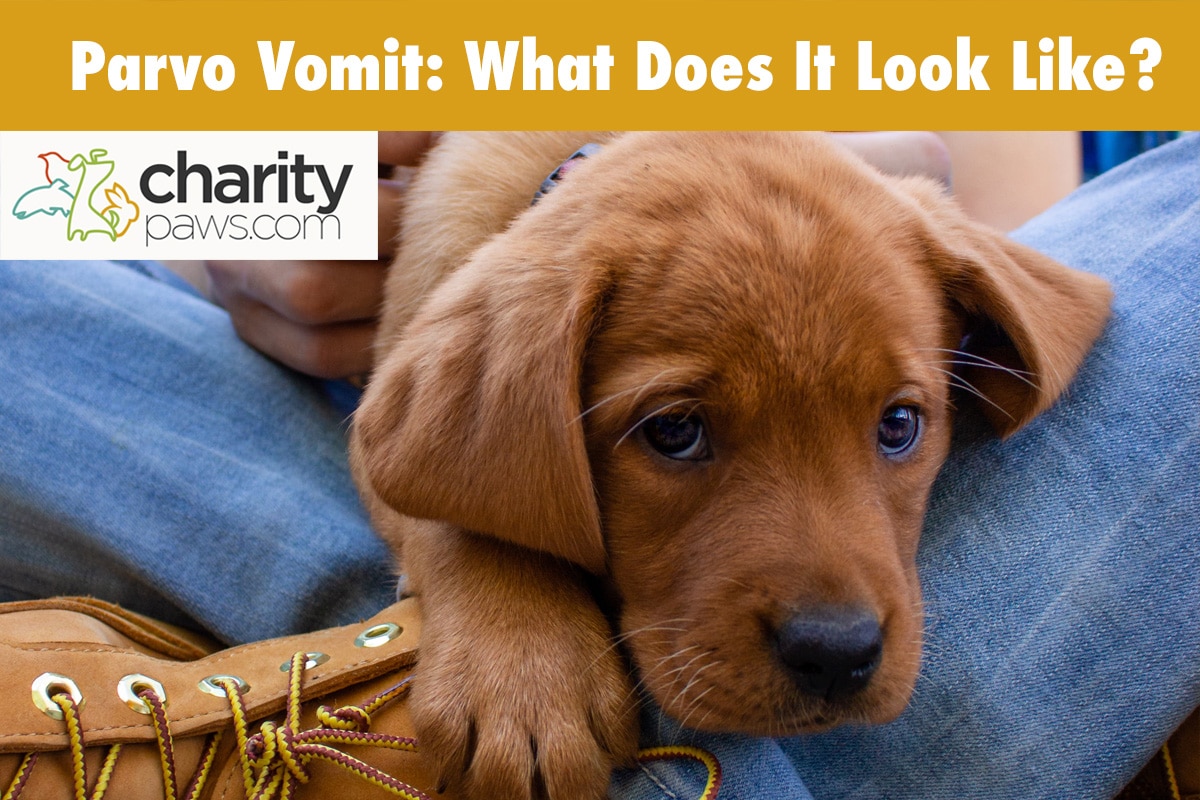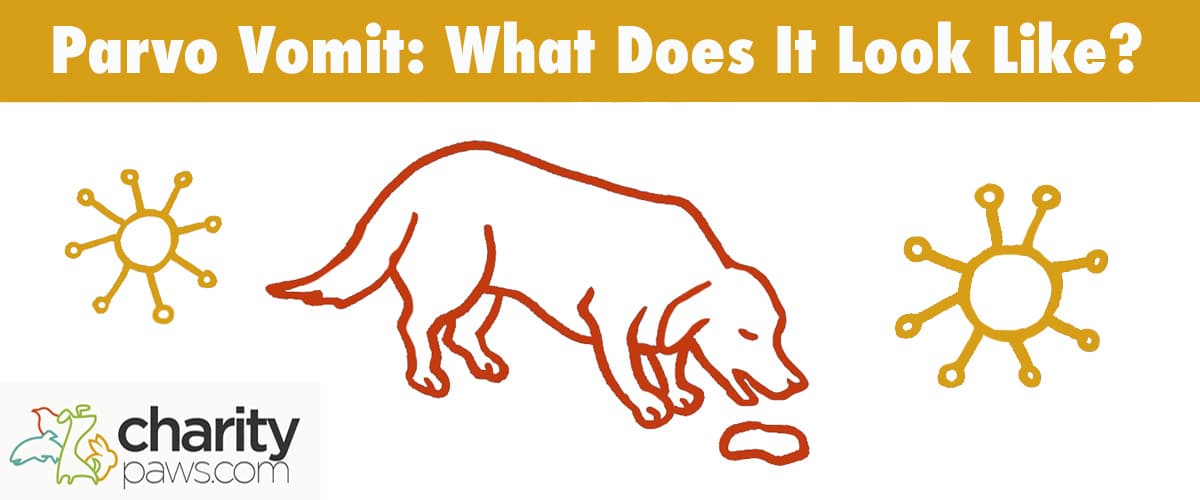Parvovirus is an illness in dogs that many people have heard about, but it may be wise to learn a bit more and have an understanding of what it is, what it looks like in dogs and how it’s treated.
In this article, we look at the symptoms of parvovirus, including whether there are things specific to this virus that you can look out for.
Some people think that the vomit or stools of a dog suffering from parvo have specific characteristics.
In this article we will answer “what does parvo vomit look like“, if it has a specific smell and what you should do if you suspect that your dog has this virus.

What Is Parvovirus In Dogs?
Parvovirus is a highly contagious disease caused by a virus that is shed in infected animals’ vomit and feces.
The virus is very hardy and can easily spread.
It attacks the gut, causing severe vomiting and diarrhea, which can lead to dehydration and collapse.
It can even be fatal in some cases, especially in young puppies, so it’s important to seek veterinary help if you think your dog is affected.
Will My Dog Vomit If They Have Parvo?
Dogs with parvovirus will have gastrointestinal symptoms as the virus primarily affects the lining of the guts, causing vomiting and diarrhea.
The following is a list of common symptoms often seen in infected dogs:
- Vomiting
- Diarrhea (often very watery and bloody)
- Reduced appetite
- Dehydration
- Abdominal pain
- Fever
- Weakness and lethargy
- Collapse
- Death in some cases
What Color Is Parvo Vomit Normally?
The color of parvo vomit can vary, so you can’t diagnose a dog based on this alone.
Dogs with this virus can vomit anything from yellow vomit through to dark brown, and you may even see some streaks of blood in it.
Blood can be seen due to the inflammation in the digestive tract, caused by repeated vomiting.
This sign again is not specific to parvovirus and can be seen in other health conditions too.
Similar is true of parvo stool.
While dogs with this condition usually have watery, bloody feces, these symptoms can be seen in other diseases too.
What Does Parvo Vomit Smell Like?
Many people find that parvo vomit smells stronger than other types of dog vomit.
It can smell foul and may even have an iron-like odor if there is blood present in it.
This isn’t always the case though, and it is not diagnostic for parvovirus, but can be seen commonly in these animals.
Is Parvo Vomit Textured Differently?
The vomit produced by a dog with parvovirus can be variable.
To begin with, there may be food in the vomit, but as things progress it is likely to become watery as the dog’s stomach empties.
Some dogs with parvo throw up froth and phlegm too, giving the vomit a frothy appearance.
How Is Parvo Virus Diagnosed?
We have established that you can’t definitively diagnose parvovirus from the appearance (vomit color) and smell of your dog’s vomit, so how is parvovirus diagnosed?
Your veterinarian will start by examining your dog looking at:
- Their hydration status
- Checking their heart rate
- Temperature
- Feeling for any abdominal pain
If they have concerns about your dog, they will suggest some further tests.
Parvovirus is usually diagnosed from a fecal swab.
A cotton bud-like swab is used to collect a small amount of fecal material for analysis.
A positive result in a dog with clinical symptoms indicates infection with parvovirus.
However, positives can be seen in dogs that have recently been vaccinated against the disease, which can confuse things.
Blood samples may also be advised to look for indicators of parvovirus.
These indicators include, low white blood cell count, but also to screen for anemia (low red blood cells) and to check your pet’s other parameters such as their liver, kidneys and blood sugar.
If results are inconclusive, your vet may send fecal samples off to the lab for further analysis.
This may include screens for other causes of bloody diarrhea like parasites and bacterial infections.
What Is The Treatment For Parvovirus?
Treatment for parvovirus is usually supportive care, as there is no specific cure for the virus.
Your vet may suggest the following to help your pet while they fight the infection:
- Intravenous fluids – many dogs with this illness become severely dehydrated and this needs correcting. The best way to do this is with intravenous fluids (fluid given via a drip) which means hospitalizing the dog during this time.
- Antinausea medication – drugs can be given to help stop the vomiting and make your dog feel less nauseous.
- Pain relief – Some animals may have a sore abdomen and gut pain with parvovirus so pain relief medication can be helpful.
- Antibiotics – These are usually given to prevent secondary infections and septiceamia from occurring, due to the damage to the guts.
- Nutrition – correct feeding is important in helping these dogs recover. If they are unable to take food voluntarily then your vet may recommend a stomach tube to help feed your dog. Giving your dog appropriate nutrition will help the guts repair more quickly.
How Can I Stop My Dog From Getting Parvo Virus?
Vaccination is the number one thing that you can do to stop your dog from getting parvovirus in the first place.
Vaccinations in young puppies can be started from 6 weeks of age onwards, depending on your individual veterinary hospital’s protocols.
It is important to not allow your dog to socialize or walk in public areas until after they have completed their vaccination course, to limit their risk of catching it.
Thereafter, your pet will need regular booster vaccinations which are given throughout their adult life.
Buying your puppy from a reputable breeder or dog rescue is also important, ensuring that appropriate steps have been taken to prevent infectious disease.
Steps such as, vaccination of the pup’s mother, keeping unvaccinated puppies away from other dogs, and the general cleanliness/hygiene of the premises.
Make sure the puppy you have chosen is not sick and seems well, otherwise you could be setting yourself up for heartache.
‘Rescuing’ a sick pup often doesn’t turn out too well.
Final Thoughts On Parvo Vomit And What It Looks Like

While vomiting and diarrhea are key signs of parvovirus the exact appearance of these can vary.
There is nothing that is specific to this virus, so the best thing to do is to get a definitive diagnosis from a vet.
This will also allow your dog to be examined and receive appropriate treatment, giving them the best chance of survival.
FAQs
Can I Know My Dog Has Parvo Based On Their Vomit Color?
No, you can’t diagnose a dog with parvo based on the color of their vomit.
You may see yellow vomit with parvo, but also brown or may even be bloody.
These colors can be seen in other disease processes too.
What Does Parvo Throw Up Look Like?
Parvovirus throw up can vary in appearance.
It may have food in it, or it could be watery, and it may even be frothy and bloody.
A foul odor is common in dogs with this illness, but diagnosis is made on examination of your dog and samples of their feces rather than the appearance of their vomit.

